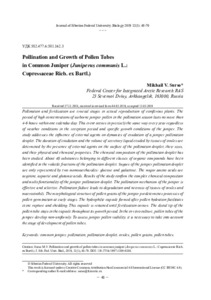Опыление и рост пыльцевых трубок у можжевельника обыкновенного (Juniperus communis L.: Cupressaceae Rich. ex Bartl.)
Скачать файл:
URI (для ссылок/цитирований):
https://elib.sfu-kras.ru/handle/2311/110036Автор:
Сурсо, М.В.
Surso, Mikhail V.
Дата:
2019-03Журнал:
Журнал Сибирского федерального университета. Биология. Journal of Siberian Federal University. Biology; 2019 12 (1)Аннотация:
Опыление и оплодотворение являются важными и наиболее ответственными этапами
в половой репродукции хвойных растений. Период массового пыления у можжевельника
составляет не более 4-6 ч и укладывается в одни календарные сутки. Эта закономерность
сохраняется из года в год и не зависит ни от погодных условий в период рецептации, ни от
особенностей места произрастания можжевельника. Изучено влияние внешних агентов
на динамику экссудации опылительной капли у можжевельника. Продолжительность
экссудации и объем выделяемого секрета тканями семязачатков зависят от наличия на
поверхности опылительной капли внешних агентов, их размеров и физико-химических
свойств. Изучен химический состав опылительной капли. В составе ее летучих фракций
идентифицировано около 40 веществ, принадлежащих к различным классам органических
соединений. В состав сахаров опылительной капли можжевельника входят только два
моносахарида: глюкоза и галактоза. В аминокислотном составе преобладают аргинин,
аспарагиновая и глутаминовая кислоты. Результаты исследований подтверждают сложный
химический состав и многофункциональность опылительной капли. Механизм опыления у
можжевельника является эффективным и избирательным. Отсутствие опыления приводит
к деструктивному типу развития тканей семязачатков и макростробилов. Морфологическое
строение пыльцевых зерен можжевельника предопределяет процессы прорастания пыльцы на
ранних стадиях. Гидрофильная капсула, образующаяся при гидратации пыльцы, способствует
разрыву и сбрасыванию экзины. Эта капсула сохраняется до момента оплодотворения. В ней
же остается и дистальный кончик пыльцевой трубки в течение всего времени ее роста. В
культуре in vitro развитие пыльцевых трубок можжевельника протекает неравномерно.
При определении показателя жизнеспособности пыльцы необходимо учитывать стадию
формирования пыльцевых трубок Pollination and fertilization are crucial stages in sexual reproduction of coniferous plants. The
period of high concentrations of airborne juniper pollen in the pollination season lasts no more than
4-6 hours within one calendar day. This event occurs in precisely the same way every year regardless
of weather conditions in the reception period and specific growth conditions of the juniper. The
study addresses the influence of external agents on dynamics of exudation of a juniper pollination
droplet. The duration of exudation and the volume of secretory liquid exuded by tissues of ovules are
determined by the presence of external agents on the surface of the pollination droplet, their sizes,
and their physical and chemical properties. The chemical composition of the pollination droplet has
been studied. About 40 substances belonging to different classes of organic compounds have been
identified in the volatile fractions of the pollination droplet. Sugars of the juniper pollination droplet
are only represented by two monosaccharides: glucose and galactose. The major amino acids are
arginine, aspartic and glutamic acids. Results of the study confirm the complex chemical composition
and multi-functionality of the juniper pollination droplet. The pollination mechanism of the juniper is
effective and selective. Pollination failure leads to degradation and necrosis of tissues of ovules and
macrostrobili. The morphological structure of pollen grains of the juniper predetermines processes of
pollen germination at early stages. The hydrophilic capsule formed after pollen hydration facilitates
exine rupture and shedding. This capsule is retained until fertilization occurs. The distal tip of the
pollen tube stays in the capsule throughout its growth period. In the in vitro culture, pollen tubes of the
juniper develop non-uniformly. To assess juniper pollen viability, it is necessary to take into account
the stage of development of pollen tubes

